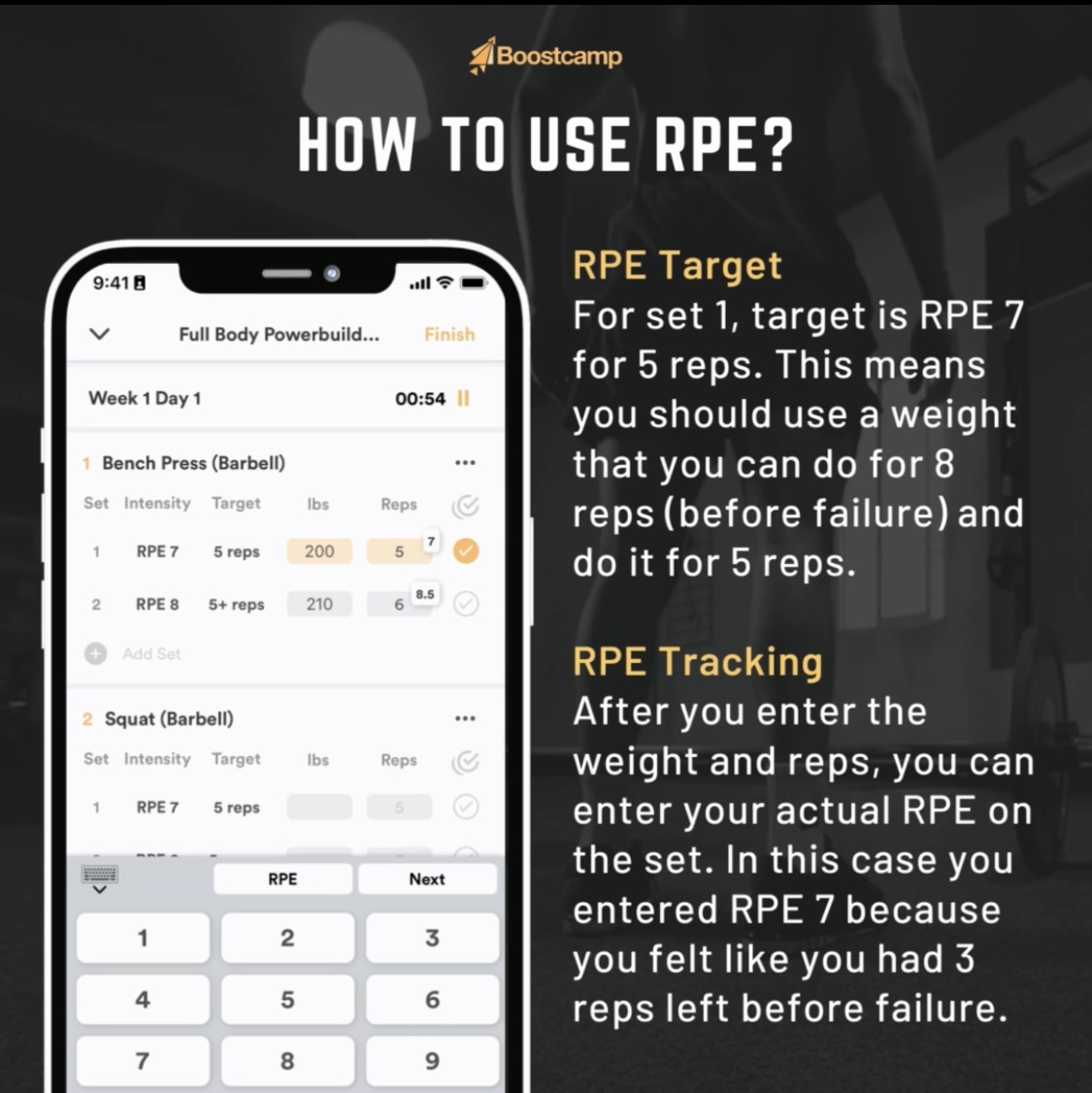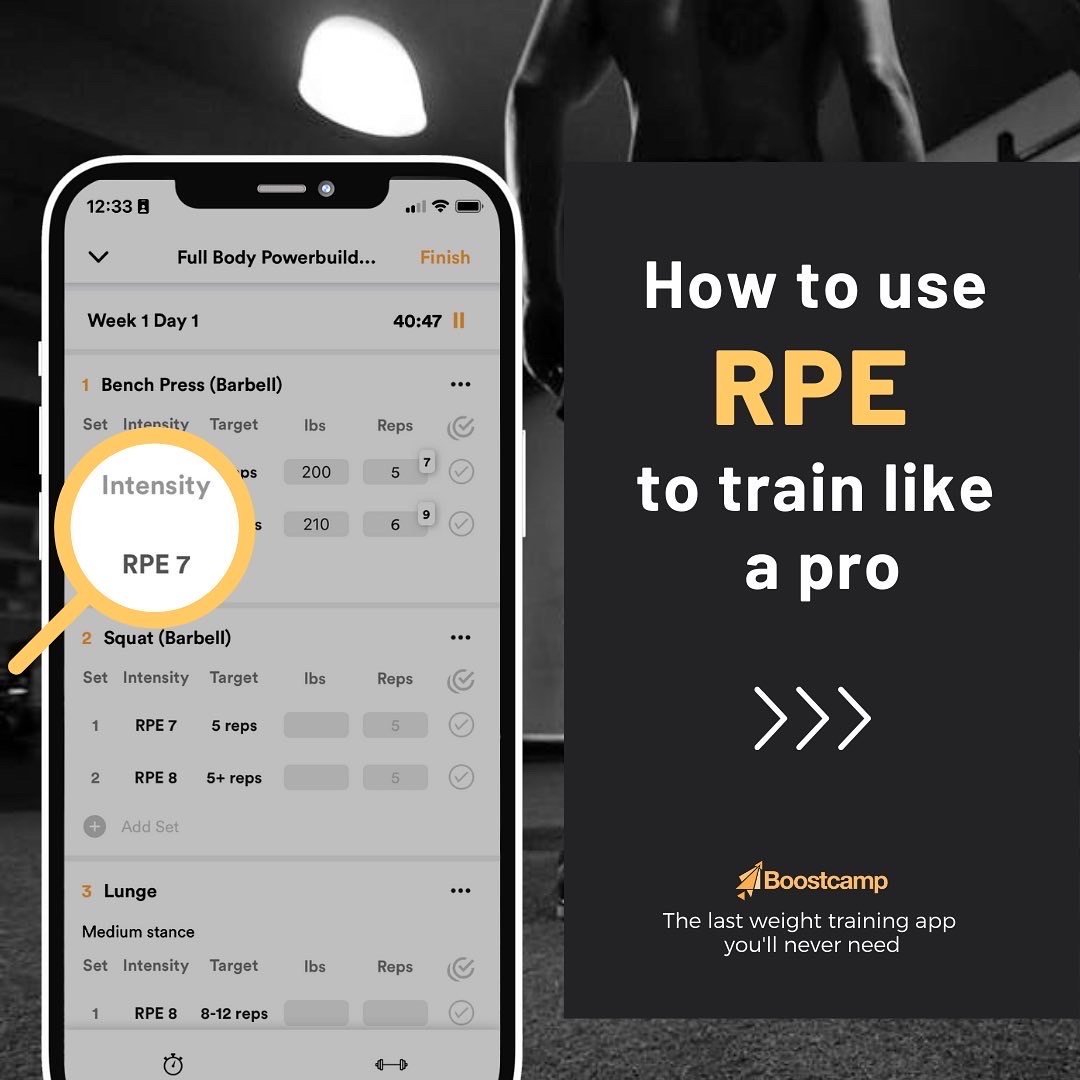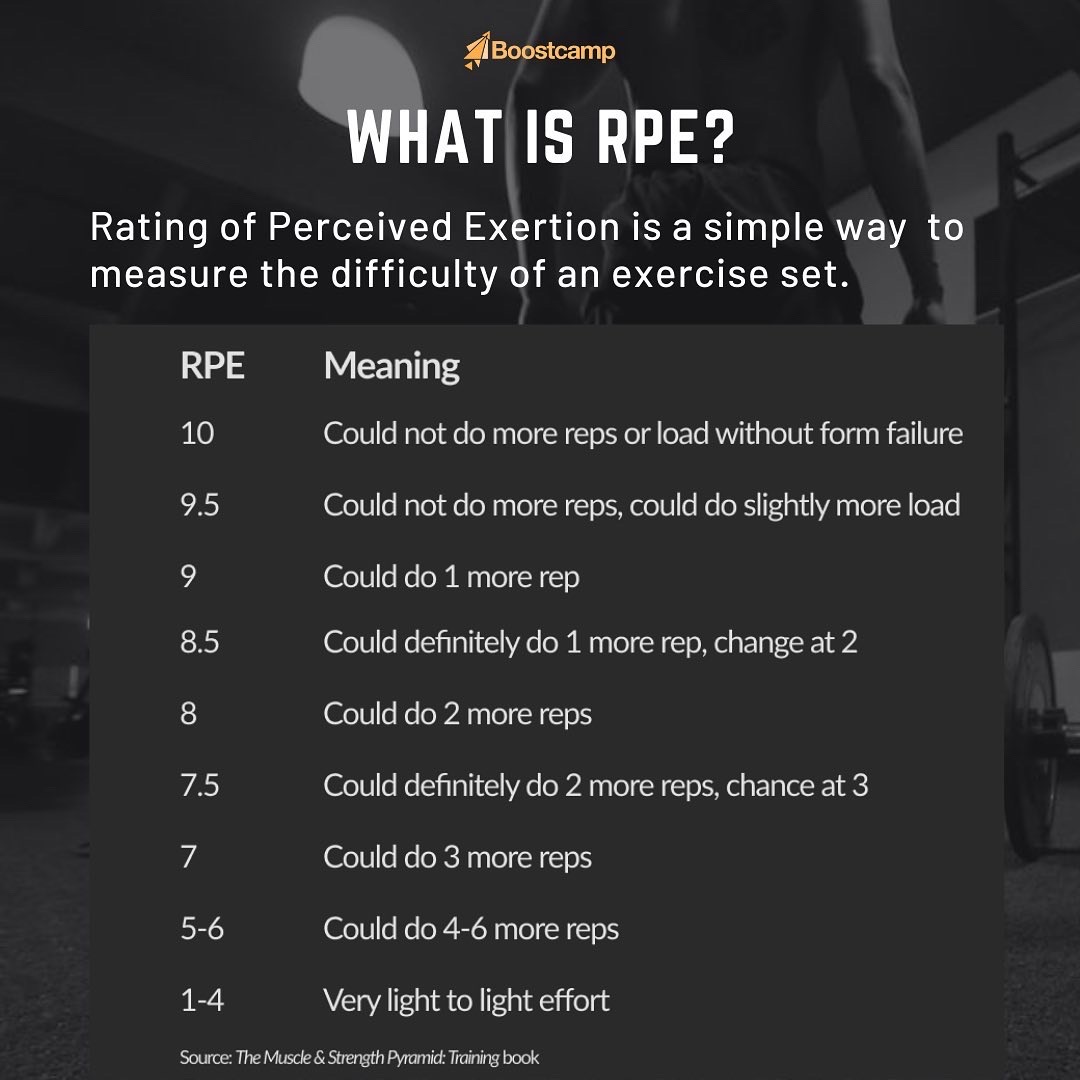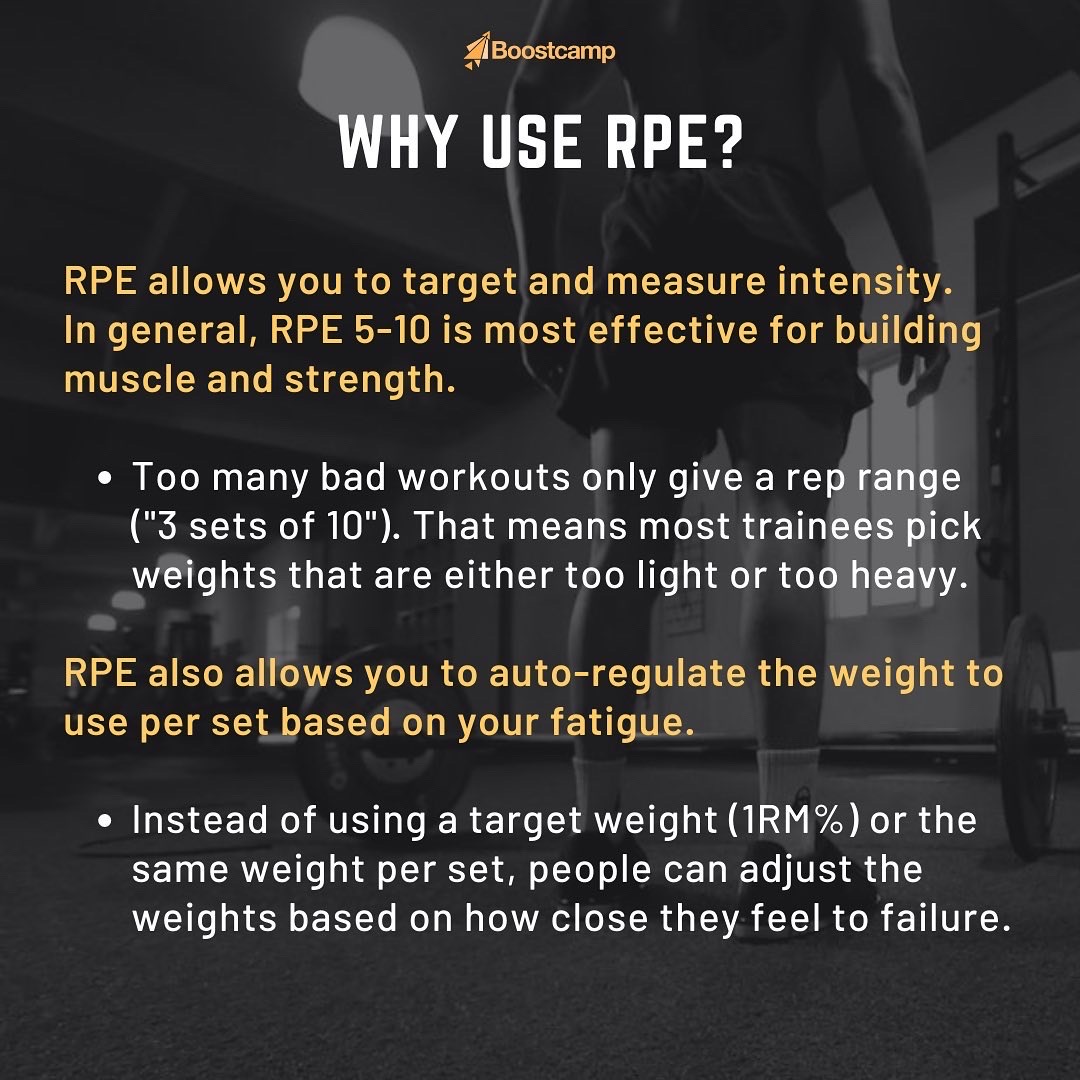The Ultimate Guide to RPE in Lifting
Written by The Boostcamp Editors
What is RPE and why is it important?
If you lift weights, whether you are a competitive powerlifter or an Olympic weightlifter, or a bodybuilder, chances are you’re probably always looking for ways to improve your training to get bigger and stronger. One tool that can be incredibly helpful, especially for intermediate and advanced lifters, is RPE (Rating of Perceived Exertion). However, RPE is not something that everyone has extensive knowledge on.
RPE is a subjective scale of 1 to 10 to measure the difficulty of a particular set on an exercise. Weight training programs will often have target RPE, which allows a lifter to choose a weight to lift based on intensity instead of a fixed target weight. This allows a lifter to progressive overload intelligently. We’ll get more into this later.
You can easily track RPE on Boostcamp App, the lasting lifting app you’ll ever need. Many free workout programs made by world-class coaches on Boostcamp have RPE targets, therefore it is important to understand how they work in order to train effectively.
In this ultimate guide, we’ll explore what the RPE scale is, how to use it for your training regimen, and why it’s such an important tool for lifters at any level to make optimal progress in the gym.
RPE Defined
Rating of Perceived Exertion (RPE) is a lifting tool to measure training intensity from the perspective of the lifter. Essentially, RPE is a way for you to subjectively assess how hard you’re working in a particular set of an exercise. RPE is a range from 1 to 10, with 10 being the most difficult and 1 being the easiest. This concept is used in many sports, including powerlifting and sometimes bodybuilding training.
However, many times lifters will take into account the RPE for compound lifts such as the bench press or squat and deadlift, as RPE is more often used in powerlifting training than bodybuilding. When it comes to bodybuilding training, there is more focus on obtaining a pump through higher volume during each set, many times using rep ranges 8-12 or even taking sets to failure.
What are the RPE Numbers?
For weight training, the RPE scale is based on how many reps in reserve (RIR) before failure you have at the end of a set. RPE 10 means you cannot do another rep without failure at the end of the set. RPE 9 means you have 1 rep in reserve at the end of a set, i.e., you could have done 1 more rep before failure. RPE 8 means you have 2 reps in reserve at the end of the set, RPE 7 with 3 reps in reserve, and so on and so forth.
Target RPE vs. Actual RPE
The concept of RPE can be further expanded into target RPE and actual RPE. Target RPE is what your coach or your program tells you to aim for in terms of intensity on the set, whereas actual RPE is how the set feels for the lifter at the end of the set. Ideally they’re the same.
Confused? Let’s see a real world RPE example.
From Bryce Lewis’ TSA Beginner Program on Boostcamp App.
For Bench Press, the target is RPE 7 for 6 reps. What does that mean? It means you want to choose a weight heavy enough that you can do for 6 reps at a difficulty of RPE 7 (i.e. rep 6 is 3 reps away from failure). Let’s say you think you can Bench Press 150 lbs for 9 reps, that means you should use 150 lbs on your first set to do 6 reps, which should be an RPE 7.
Now let’s say you did your first set of 150 x 6 and it felt super hard like you could only do 1-2 reps more after the 6th rep before failing, then you know you overestimated the weight and that set was probably an RPE 9-10. That means for your 2nd and 3rd set, you should lower the weight (maybe 140 lbs) in order to get 6 reps at target RPE 7.
RPE is Based on Reps in Reserve (RIR)
It is important to note that RPE is not a predefined number of reps. Instead, RPE is based on reps in the tank before failure, or Reps in Reserve (RIR) at the end of the set.
Here is an example to show the same RPE with different reps:
Let’s say your Bench Press 1 rep max is 225 lb. That means if you benched 225x1, you just did a set at RPE 10 (or RIR 0) since you can’t do another rep before failure.
Let’s say your Bench Press 5 rep max is 185 lb. That means if you benched 185x5, you also did a set at RPE 10 (or RIR 0) since you can’t do another rep before failure.
Let’s say your Bench Press 1 rep max is 225 lb. That means if you benched 215x1, you just did a set at RPE 9 (or RIR 1) since you can do another rep before failure.
Let’s say your Bench Press 5 rep max is 185 lb. That means if you benched 185x4 you just did a set at RPE 9 (or RIR 1) since you can do another rep before failure.
Your RPE could change by set
RPE rating can change by set for the same exercise depending on a number of factors like fatigue, pain, and overall fitness level. In the above example, while your first set of bench press might be 185x4 is RPE 9, your second set where you’re more tired could be RPE 10. Additionally, RPE 9 weight could be different on different training days; if you had 2 days of rest between bench sessions vs 1 day, you can probably push more weight at the same RPE.
Sounds complicated? Let’s learn why you should learn RPE before we get into the how of RPE.
WHY USE RPE?
Have you ever done a lifting program where it just tells you to do an exercise at 3 sets of 10 reps with no other explanation? Or do you ever do your sets and feel like you could've done more? How hard are the sets supposed to be? Are you supposed to go to failure on each set?
As a lifter this is confusing and not optimal for long-term progression. If you go to failure on every set (i.e. RPE 10), you’ll probably fatigue quickly, overtrain, or at worse risk injury. If you go too light on every set (i.e. RPE 5-6), you’re probably not training hard enough to actually build muscle mass and strength. As you get more advanced, varying RPEs on exercises, sets, days, and even weeks will be even important to making gains.
So why should you learn RPE (and RIR) for lifting? There are many excellent reasons why RPE is a valuable training tool for novice lifters and beyond:
Provides an assessment of difficulty. RPE allows the lifter to assess if they’re working hard enough. Generally speaking, doing any sets below RPE 6 is junk volume, i.e., sets that are more like warmups and unlikely to build muscle or strength.
Prevents injury by training smarter. By using RPE targets, lifters can train smarter. For example, while going to failure (RPE 10) has its place in training, max effort sets cause much more fatigue and must be utilized correctly to avoid injury.
Allow lifters to auto-regulate load. Unlike 1RM % sets that follow strict target weight numbers, RPE targets allow the lifter to assess what weight to choose to achieve the optimal level of difficulty. This can be particularly useful for cross training athletes or advanced athletes where actual strength can vary day by day.
Intermediate and advanced programs have RPE. Most well structured gym programs have RPE targets built in, so unless you learn it you are not going to maximize your training to build muscle and strength.
HOW TO USE RPE
To use RPE in your training routine, you should make it a habit to assess and track your RPE after working sets. An experienced lifter and coach will be very good at estimating their RPE, whereas beginners to RPE will take a few sessions and perhaps weeks and months before they can properly assess an accurate number.
There are four ways to estimate RPE. Note that RPE is subjective and personal, so use these methods as a starting point.
Method 1: Perform a max rep set
Warm-up, starting with the bar and do a few sets where you gradually increase weight to acclimate to the max rep set. There is no need to go near failure on your warmup sets.
Determine the target rep number you want to find the RPE for. For example, if you want to know your RPE 9 for 5 reps of bench press, you’ll want to make an educated guess on what weight you can hit for around 4-6 reps.
Perform the max rep set, which means going to failure while maintaining good form. Don’t stop until you’ve hit failure or you know for sure you can’t do another rep. If you’re doing free weights, it is best to get a spotter who can help you.
Voila! If you did 6 reps on the max effort set, then you know RPE 9 would be 5 reps. If you did 7 or more reps, you may need to increase weight from the max effort set to get to RPE 9 at 5 reps. If you did 3-4 reps, you may need to decrease the weight from the max effort set.
Method 2: RPE to Rep Max Converter
Go to this website to find a free RPE to RM converter
Find your 1RM by entering a weight and rep that you know you can do at max effort
Voila! Look at the chart to find your target rep and RPE. Note that this calculator is just a rough estimate of what you can do as a starting point, but what your actual RPE is you’ll have to assess yourself based on that set and prior experience. The whole point of RPE is that it is subjective and not based on Rep Maxes.
RPE to 1RM Conversion Chart

In this example, let's say your target RPE is 9 with a rep target of 5. Look on the chart to find Reps 5 and RPE 8, which is 83.7%. If you know that your 1RM is 100 lbs, then you should lift 84 lbs for 5 reps to get RPE 9. This is just a rough estimate but can be a good starting point for you to go off of.
Method 3: Ask a coach to check for you
Ask a coach or someone experienced with RPE to watch your set. You can also record your set and share it in online lifting communities like Reddit (r/strength_training or r/boostcamp) to crowdsource some opinions.
Ideally, this person would have some prior knowledge of your training so they can make a more educated assessment. For example, some lifters are grinders, meaning even if the bar speed slows down drastically they can still do 2-3 more reps.
Method 4: Mindfully practice using RPE
This is by far the most important method, but also takes the most time.
Before performing every set, assess the target RPE and target rep you’re aiming for, then thoughtfully think about the proper weight to use on the set.
During the set, be mindful of how each rep feels and the target RPE you’re aiming for. Stop the set when you’ve hit the target RPE.
After the set, assess how close your actual set was to your target RPE and target rep. Make adjustments to the weight as necessary.
Record your actual RPE on Boostcamp App. This is really easy to log on the app and you can find more information below.
Use this knowledge the next time you train to best find a weight to use.

How to use RPE with 1RM %
Target RPE and target weight (based on 1 Rep Max %) is often used in conjunction in a training program. This is common in intermediate to advanced level powerlifting programs.
For example:
Bench Press: 5 reps at 80% of 1RM at RPE 8
Assuming your 1RM bench is 200 lbs, this means your target weight and reps are 160 lbs x 5 reps with a target intensity at RPE 8.
In this scenario with both target weight and target RPE 8, you will generally adjust weight to keep the target reps at 5 and target intensity at RPE 8. For example, if you are feeling extra fatigued and think you can only do 160 lbs x 3-4 reps before failure, then you should lower the weight. For example, you would lower to 150 lbs x 5 reps at RPE 8.
RPE FAQ
What does RPE stand for?
RPE stands for Rating of Perceived Exertion. People often incorrectly think RPE stands for Rate of Perceived Exertion, which is wrong. RPE is a rating, not a rate.
What is RPE in lifting?
RPE was developed to help athletes subjectively assess the difficulty of their training. For general athletes like running and sports, an RPE 10 means max effort (can’t continue), RPE 9 means very hard, RPE 7-8 means vigorous activity, and 4-6 being moderate.
RPE scale was specifically adopted for lifting by the great powerlifting educator Mike Tuchscherer, who made the RPE scale more numbers based, with RPE 10 being max effort (can’t do another rep before failure), RPE 9 being close to failure (can only do 1 more rep before failure), RPE 8 (can only do 2 more reps), etc.
RPE Scale for Lifting
RPE 10 = Could not do more reps without failure
RPE 9 = Could do 1 more rep
RPE 8 = Could do 2 more reps
RPE 7 = Could do 3 more reps
RPE 5-6 = Could do 4-6 more reps
RPE 1-4 = Very light effort
How to use RPE on Boostcamp App?
RPE is an important tool in a lifter’s toolbox. As such, we’ve built in an RPE tracking to the Boostcamp App’s workout UI. You can enter RPE when following training programs or when logging your own custom workouts.
To enter RPE, simply enter your weight and reps in the tracker columns, and then click the RPE button on the top of the keyboard to select RPE.
To view your past weights and RPEs, simply click an exercise name where you can pull up your training history.
What is the difference between RPE and RIR?
RPE (Rating of Perceived Exertion) and RIR (Reps in Reserve) are both tools to help lifters quantify the level of effort or intensity during weight training.
RPE is a measure of the difficulty on a particular set. RPE is typically rated on a scale of 1 to 10, with RPE 10 being max effort (can’t do another rep before failure), RPE 9 being close to failure (can only do 1 more rep before failure), RPE 8 (can only do 2 more reps), etc.
RIR, on the other hand, is a measure of how many reps you have “left in the tank” before failure on a set. RIR is typically rated on a scale of 0 to 5, with RIR 0 being max effort (can’t do another rep = 0 reps left in the tank), RIR 1 being 1 rep left in the tank, RIR 2 being 2 reps left, etc.
So how is RPE and RIR related? Well, RPE is not based on a specific number of reps in a set, but rather it is based on Reps In Reserve (RIR). In practice, these two terms are related and often used interchangeably, except the numbers are in reverse order.
Source: Muscle and Strength Pyramid by Dr. Eric Helms and co.
RIR to RPE conversion
RPE 10 = RIR 0 (i.e. no reps in reserve = max effort)
RPE 9 = RIR 1 (1 rep in reserve)
RPE 8 = RIR 2
RPE 7 = RIR 3
Etc…
Confused yet? Let’s see some real world RPE and RIR examples.
Let’s say your Bench Press 1 rep max is 225 lb. That means if you benched 225x1, you just did a set at RPE 10 or RIR 0.
Let’s say your Bench Press 5 rep max is 185 lb. That means if you benched 185x5, you also did a set at RPE 10 or RIR 0, since you can’t do another rep before failure.
If you benched 185x4, but you could have technically done 185x5, then you just did a set at RPE 9 or RIR 1. If you benched 185x3, then you did RPE 8 or RIR 2 since you could have done 2 more.
How do I calculate RPE?
There are a few ways to estimate RPE. Note that RPE is subjective and personal, so use these methods as a starting point.
Assess your RPE before, during, and after a set of an exercise. Simply by being mindful, you can better get a sense of how close you are relative to failure. Track your RPE for every working set during the session and throughout multiple weeks to practice.
Record yourself doing a set then take a look at the video. Generally, the closer you are to failure (the higher the RPE), the more it might look like you’re struggling. For example, the bar might be slowing down in later reps or your form might change as you fatigue.
Ask a coach or someone experienced in the gym to assess for you. Even posting the video on lifting forums like r/lifting or r/strength_training to get some feedback could be helpful to help you avoid blind spots.
Trial and error. Do a set for as many reps as possible (while maintaining good form) for a particular weight. When you hit failure, you know that’s around RPE 10, and you can then make a better educated guess on what RPE 9 or 8 is for different rep ranges.
RPE to Rep Max converter. You can check out this website. A helpful tool that Mike Tuchscherer developed is the RPE to RM chart, which can help you convert your Rep Max numbers into RPE at different reps. Note that like the 1RM calculator, this is but a rough estimate but a good starting point nonetheless.
RPE to Rep Calculator

In this example, let's say your target RPE is 8 with a rep target of 5. Look on the chart to find Reps 5 and RPE 8, which is 81.1%. If you know that your 1RM is 100 lbs, then you should lift 81 lbs for 5 reps to get RPE 8.
As mentioned above, this calculator is but a rough estimate of RPE and 1RM conversion, but can be a good starting point.
Who developed the RPE scale?
The RPE scale for weight training, specifically in a powerlifting context, was popularized and developed by IPF champion and coach Mike Tuchscherer. RPE was further researched by Dr. Eric Helms and Dr. Michael Zourdos at the FLorida Atlantic University and at the Sports Performance Research Institute in New Zealand at Auckland University of Technology.
What RPE should you train at?
There is not one “optimal” RPE you should train at. That said, to build muscle and strength you should at least be aiming for an RPE 6, as anything below can be considered warmups as it won’t produce enough training stimulus to be effective. Most working sets should be done between RPE 7 to RPE 9.
You can find many free lifting routines on Boostcamp App with intelligently designed RPE targets.
What does RPE 5 mean in lifting?
RPE 5 means 5 reps in reserve (RIR 5) in a set. This means that in a particular exercise set, you want to find a weight and do reps to stop with 5 reps “left in the tank”. This ensures that you’re training at a difficulty level that is fairly light.
For example, if the target is 5 reps at RPE 5, that means you find a weight that you can do for a maximum of 10 reps before failure, but you stop at rep 5. RPE 5 is generally a warmup weight or a technique practice weight.
What does RPE 6 mean?
RPE 6 means 4 reps in reserve (RIR 4) in a set. This means that in a particular exercise set, you want to find a weight and do reps to stop with 4 reps “left in the tank”. This ensures that you’re training at a difficulty level that is marginally difficult.
For example, if the target is 8 reps at RPE 7, that means you find a weight that you can do for a maximum of 12 reps before failure, but you stop at rep 8.
What does RPE 7 mean?
RPE 7 means 3 reps in reserve (RIR 3) in a set. This means that in a particular exercise set, you want to find a weight and do reps to stop with 3 reps “left in the tank”. This ensures that you’re training at a difficulty level that is moderately difficult.
For example, if the target is 10 reps at RPE 7, that means you find a weight that you can do for a maximum of 13 reps before failure, but you stop at rep 10.
What does RPE 8 mean?
RPE 8 means 2 reps in reserve (RIR 2) in a set. This means that in a particular exercise set, you want to find a weight and do reps to stop with 2 reps “left in the tank”. This ensures that you’re training at a difficulty level that is moderately difficult.
For example, if the target is 12 reps at RPE 8, that means you find a weight that you can do for a maximum of 14 reps before failure, but you stop at rep 12.
What does RPE 9 mean? How hard is RPE 9?
RPE 9 means 1 rep in reserve (RIR 1) in a set. This means that in a particular exercise set, you want to find a weight and do reps to stop with 1 rep “left in the tank”, i.e. 1 rep shy of failure. This means you’ve done a set that is very difficult.
For example if the target is 5 reps at RPE 9, that means you find a weight that you can do for a maximum of 6 reps, but you stop at rep 5.
What does RPE 10 mean?
RPE 10 means 0 rep in reserve (RIR 0) in a set. This means that in a particular exercise set, you want to find a weight and do reps to stop with no reps “left in the tank”, i.e. at failure. This means you’ve done a set that is max effort.
For example if the target is 3 reps at RPE 10, that means you find a weight that you can do for 3 reps and won’t be able to do a 4th rep.
Is RPE 10 good?
RPE 10 means that you are training at failure with maximum effort. The benefit of going to failure is that you completed the set at the most difficulty, hence accumulating the most stimulus for your muscles to get stronger and bigger.
The downside is that RPE 10 sets are the most fatiguing, and used incorrectly can actually result in less total workout volume (hence lower stimulus to build muscle and strength) and you also run greater injury risk.
The point is that RPE 10 is not inherently good or bad. It is simply something that requires you to program intelligently to make optimal progress.
RPE-based programs on Boostcamp App
To find FREE science-based lifting programs with RPE targets, download Boostcamp on iOS and Google Play Store. Boostcamp is the last lifting app you'll ever need, with proven programs for powerlifting and bodybuilding made by world-class coaches like Dr. Eric Helms, Bryce Lewis, Jonnie Candito, Geoffrey Schofield, Alex Bromley, Alberto Nunez, and many more. Boostcamp also has features that allow you to create your own workout routines, log your own custom workouts, and track your training analytics. Our vision at Boostcamp is to make the last lifting app you'll ever need.




